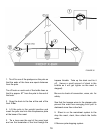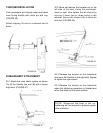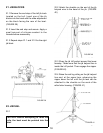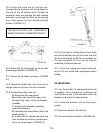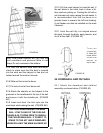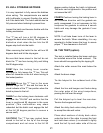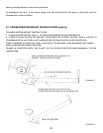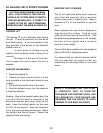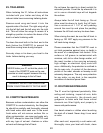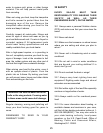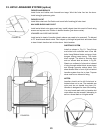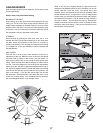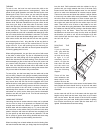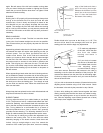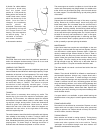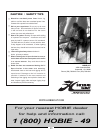
edge of the blade and draw a
pencil line along that length.
Measure the distance from the
pencil line to the most forward
spot 12" down the blade from
the bottom of the casting..
29
again. Be well aware of the hull and crossbar coming down
over your head. Holding the crossbar or righting line will also
insure that you remain with the boat when it is righted. Climb
aboard and continue sailing.
DOCKING
Docking the 21 SC properly will prevent damage. Always dock
and rig on the leeward side of a dock (the side the wind
reaches last). Come in slowly and always be aware of the
wind direction so you can properly de-power the boat when
needed. The stronger the wind the more difficult the docking
will be. Until you feel confident, you may want to practice with
a friend who will remain on the dock and help slow you down if
necessary.
BEACH LANDINGS
Landing on a beach is simple. The idea is to reach the beach
in the point of sail nearest straight into the wind as possible.
This will assure that you can properly de-power the sail once
beached.
Approaching a beach when the wind is blowing from the beach
out towards the water will require some planning so that you
maintain power. Turn into shore just before the hulls or
rudders touch bottom. Plan so the final tack towards the
location you choose to land is the tack that is nearest straight
into the wind. Get a little closer to the beach than you need on
the pervious tack to account for wind shifts in direction and
speed. This will give you a little room for error. This will allow
you to point a little further away from the wind after the tack to
gain speed before heading up into the beach to de-power at
the last moment.
When approaching a beach when the wind is blowing onshore,
sail in towards the beach from either side of the landing spot.
Sail in just short of touching the bottom with the rudders. Allow
some distance to turn the boat out towards the water and into
the wind just out from the landing spot. Turn sharply to head
into the wind and stall the boat. Raise the rudders and drift
back onto the beach.
Always keep the boat pointed into the wind while beached and
keep the sail trimmed out and un-cleated.
RUDDER TUNING
You may adjust the rake of your rudder blades on your Hobie
21 SC. The amount of rake in a rudder blade affects the "feel"
at the tiller. Basically, more forward blade rake neutralizes the
pull on the tiller and less forward rake increases the pull on the
tiller. Tuning blades for a comfortable feel is a matter of
individual preference but a close to neutral "feel" generally
provides the best steering. The following sketches are of a
Hobie 16 rudder assembly but the adjustments are the same.
1) The first step in making any rudder rake adjustment is to
determine the existing rake. This is done with the rudder
assembly hanging on the boat's transom, blade down and
locked. Using a straight edge or snap line, extend the
centerline of the rudder pivot pins down, across the leading
Rudder blade rake is pre-set at the factory to 1-1/8". This
amount will be best for the average sailor and is a good
starting point from which to begin any adjustments.
2) To make any adjustment
to the rake, unlock the tiller
arm from the rudder
housing and leave it
unlocked.
3) If you wish to increase
the amount of forward rake
in the rudder blade, turn the
rake adjusting screw
counterclockwise using a
3/16" Allen wrench. Determine the increase in the rake by
extending a new line from the centerline of the pivot pins. Re-
measure the distance from the pencil line to the leading edge.
Continue to adjust and measure until you have the desired
amount of forward rake.
4) If you wish to decrease the amount of forward rake turn the
adjusting screw clockwise using a 3/16" Allen wrench. Check
the decrease in the rake by the procedure in step 3 above .
5) Next, while holding the rudder forward against the lower
casting, carefully latch the tiller arm down onto rudder housing.
Loosen the adjusting screw on top of the tiller arm about 3/4
turn. Slide the adjusting screw forward (toward bow of boat)
until it stops, then retighten. See sketch C.
Screw
Sketch B
1-1/8"
Aft for more pull on
the tiller
Forward for less
pull on the tiller
12"
Sketch C
Screw



